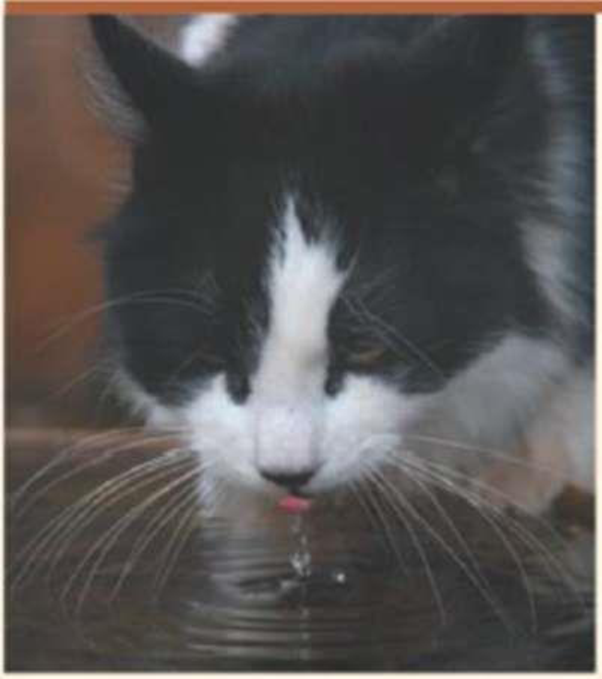
SYNTHESIZE YOUR KNOWLEDGE

How do cats drink? Scientists using high speed video have shown that cats use an interesting technique to drink aqueous substances like water and milk. Four times a second, the cat touches the tip of its tongue to the water and draws a column of water up into its mouth (as you can see in the photo), which then shuts before gravity can pull the water back down. Describe how the properties of water allow cats to drink in this fashion, including how water's molecular structure contributes to the process.
Want to see the full answer?
Check out a sample textbook solution
Chapter 3 Solutions
EBK CAMPBELL BIOLOGY
Additional Science Textbook Solutions
Microbiology: An Introduction (13th Edition)
Human Anatomy & Physiology
Biology: Life on Earth with Physiology (11th Edition)
SEELEY'S ANATOMY+PHYSIOLOGY
Human Biology: Concepts and Current Issues (8th Edition)
- A patient needs 1mg of a medication. The Australian Injectables Drug Handbook states that each gram of this medication is to be mixed with 10mL of water over 3-5 minutes via IV bolus. After preparing the medication, how many mL per minute would you administer if you do it over 3 minutes? Please do it in dimensional analysis or something please show work. I'm confusedarrow_forwardExercise C: Spectrophotometry Watch this video to learn how a spectrophotometer works. For additional information, you can read about using a spectrophotometer in your textbook’s “BioSkills 8: Using Spectrophotometry”. A spectrophotometer was used to determine the absorbance of 2 pigments between 400 nm and 710 nm, the range of wavelengths that is associated with visible light. The table below contains the absorbance values for each pigment (“Pigment 1” and “Pigment 2”) at wavelengths separated by approximately 10 nm. Wavelength Pigment 1 Pigment 2 400 0.097 0.117 410 0.088 0.127 420 0.099 0.143 430 0.113 0.158 440 0.129 0.181 450 0.158 0.184 460 0.145 0.171 470 0.085 0.164 480 0.041 0.143 490 0.024 0.089 500 0.022 0.048 510 0.019 0.023 520 0.018 0.014 530 0.020 0.010 540 0.019 0.008 550 0.020 0.008 560 0.022 0.009 570 0.023 0.008…arrow_forwardIn an experiment, a 0.001 (mole fraction) solution of polysaccharide in water is made and is placed in the compartment A. Compartment B is filled with pure water. The two compartments are separated by a porous semi-permeable membrane that allows the exchange of water molecules between the two compartments, but not that of the larger polysaccharide molecules. part 1: Show that the chemical potential of water in compartment A is lower than that in compartment B by 2.48 J/mol.arrow_forward
- A fish swims into cold water. How should it regulate so that the cell membrane continues to have the same fluidity as usual? (more than one answer may be correct) which are correct a.increase the length of lipids with short hydrocarbon tails b.increase the number of steroids in the cell membrane c.more saturated lipids in the membrane d.reduce the proportion of lipids with short hydrocarbon tails e.more unsaturated lipids in the cell membranearrow_forwardDo not handriting solutionarrow_forwardManufacturers make carbonated drinks by forcing pressurized carbon dioxide gas into flavored water. A chemical reaction between water molecules and some of the CO2 molecules creates hydrogen ions (H+) and bicarbonate, which is a buffer. In your opinion, is this reaction likely to raise the pH of a soda above 7, or lower it? Give your reasoning.arrow_forward
- Biology: Discuss the many properties of water H2O? And also give several examples of the important functions of water in living organisms. Discuss your answer in detain and in length (many words).arrow_forwardElectrically neutral molecules can pass through cell membranes more easily than charged molecules can. Aspirin has a carboxylic acid group with a pKa value of 3.5. In order to be absorbed into the bloodstream it must pass the membrane lining the stomach and intestine. Would you expect more aspirin to be absorbed in the stomach (pH 1) or in the small intestine (pH 6)?arrow_forwardBased on the pH of your drug, if your drug was in a high concentration in the blood,how would it affect the pH of your blood. Would it cause acidosis or alkalosis, and how would you treat this? drug Lipitor ph is 7 it's acidosis?arrow_forward
- Information: Osmotic pressure is the pressure that a solvent exerts against a semipermeable membrane, such as a cell membrane. The higher the solute concentration, the lower the osmotic pressure. Red blood cells have an osmotic pressure equal to that of a 0.90% (m/v) solution of sodium chloride and 5.0% (m/v) solution of dextrose. A solution that has a higher concentration that this is called hypertonic; one with a lower concentration is called hypotonic. Osmotic pressure is an important factor affecting cells. Osmoregulation is the homeostasis mechanism of an organism to reach balance in osmotic pressure.Hypertonicity is the presence of a solution that causes cells to shrink.Hypotonicity is the presence of a solution that causes cells to swell.Isotonicity is the presence of a solution that produces no change in cell volume.When a biological cell is in a hypotonic environment, the cell interior accumulates water, water flows across the cell membrane into the cell, causing it to…arrow_forwardFor dinner you eat 2 slices of a 14" thick crust pizza. Each slice contains 311 Cal. How many minutes would you have to swim to burn the amount of calories in those 2 slices of pizza if you burn 500 kcal/hr swimming? Round your answer to the nearest tenths place.arrow_forwardAlice reads another paper which seeks to elucidate the interaction of GLUT1, LAT1 and the movement of water. In the paper, the authors set up artificial cells which mimic the endothelial cells. Embedded in the artificial cell membrane is a deformed GLUT1 protein which does not work, a normal LAT1 protein and aquaporins. The artificial cell is submerged in a beaker of water which contains 10 picomole of phenylalanine. After several minutes where will water move? a) Water will move out of the artificial cell. b) Most of the water will move out of artificial cell. A little will move in. c) Water will move into the artificial cell. d) Most of the water will move into the artificial cell. A little will move out.arrow_forward
 Human Biology (MindTap Course List)BiologyISBN:9781305112100Author:Cecie Starr, Beverly McMillanPublisher:Cengage Learning
Human Biology (MindTap Course List)BiologyISBN:9781305112100Author:Cecie Starr, Beverly McMillanPublisher:Cengage Learning Biology: The Dynamic Science (MindTap Course List)BiologyISBN:9781305389892Author:Peter J. Russell, Paul E. Hertz, Beverly McMillanPublisher:Cengage Learning
Biology: The Dynamic Science (MindTap Course List)BiologyISBN:9781305389892Author:Peter J. Russell, Paul E. Hertz, Beverly McMillanPublisher:Cengage Learning

